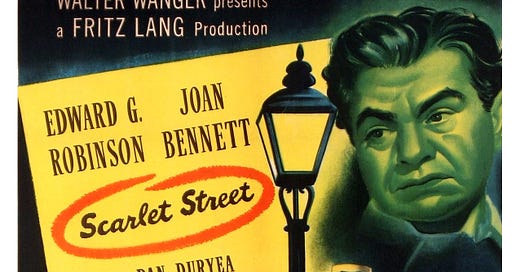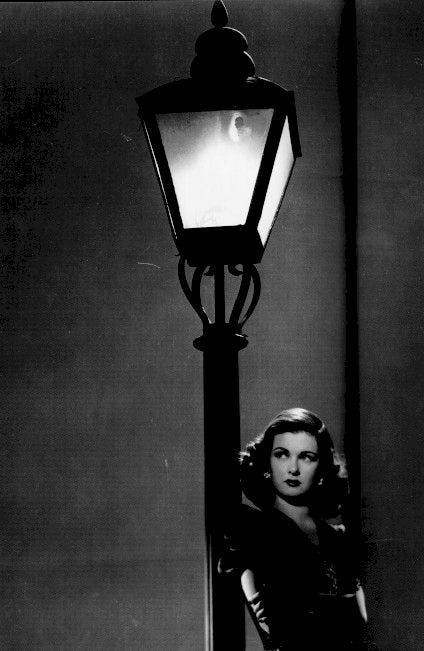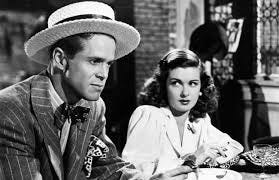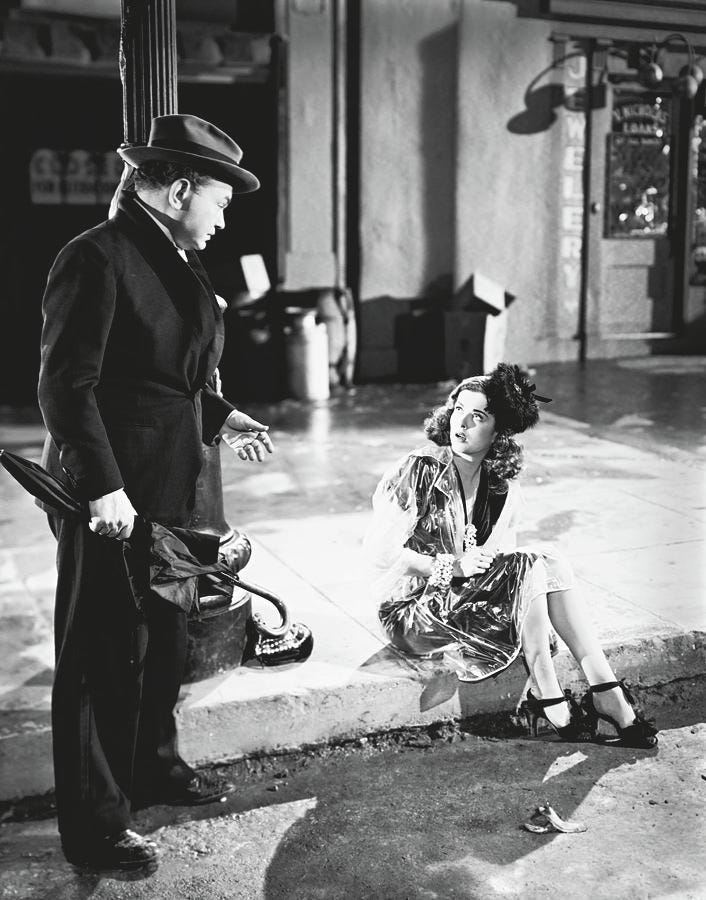With an excellent cast of noir and crime film legends that includes perennial tough guy actors Edward G. Robinson and Dan Duryea competing over cruel and beautiful femme fatale Joan Bennett, and directed by one of the early masters of the thriller genre (the incomparable Fritz Lang), Scarlet Street is one of the finest noirs ever made. The film sets up a story that is teeming with suspense as cashier Edward G. Robinson saves Joan Bennett from a beating by Dan Duryea. Feeling inadequate with his job as a cashier, for which he was just awarded a watch at a celebration of his years on the job, he claims to be a successful artist to impress her. With his wife being left a fortune by her first husband, Robinson starts taking out loans to take Bennett out and loan her money so she can put up appearances as a successful actress herself. While Robinson begins to fall in love with Bennett she’s secretly dating criminal scam artist Duryea, and what Robinson thought was a random mugging at the beginning of the film is just a regular occurrence for the abusive Duryea and the seemingly demure and shy Bennett. Duryea, also thinking Robinson is a huge artist, convinces Bennett to keep leading Robinson on. She continually asks for money, which Duryea spends, and never reciprocates his love. She claims it’s because he’s married, leading him to begin thinking about getting his wife out of the way. When his wife threatens to throw all his art in the trash, Robinson rents a high end apartment for Bennett and moves his artwork there. We all know things will devolve from there, but how and the journey there are the important parts, and I don’t want to give too much away.
Edward G. Robinson was by this point an established superstar in the crime and noir genres, having first caught fire with his role as Caesar Enrico Bandello, aka Rico, in Mervyn LeRoy’s pre-code gangster masterpiece Little Caesar. Robinson became so synonymous with the tough talking gangster that his snarling “yeah, see?” is still imitated to this day when someone discusses old time gangster movies. A year later, Robinson showed his more human side in LeRoy’s Best Picture nominated Five Star Final, where he played a sympathetic newspaper editor who fears that sensationalistic journalism will ruin lives when he witnesses how a woman accused of a murder decades earlier is dragged through the mud just as her son is about to marry into a well to do family. His career would alternate between roles as the hard as nails gangster or cop (or an insurance adjuster in Billy Wilder’s seminal noir classic Double Indemnity) and less sensational dramas that allowed him to show his side as an actor’s actor. He is, in my opinion, not just one of the biggest stars of Hollywood’s golden era but one of its finest performers with a career that spanned six decades in the business, working until his death in 1973.
Dan Duryea is another favorite of mine in these noir films, as he’s another great actor very adept at playing the heavy that would often be cast in the role of the villain. He’s more slimy than menacing in this film, but he would show that harder edge in movies like Too Late For Tears, where he is very menacing and cruel, and really show his range in Chicago Calling as a down on his luck alcoholic father in Los Angeles who finds out his little girl is injured in a car crash and struggles to do whatever he has to in order to keep his phone from being disconnected so he can be kept informed about what’s going on. He is a standout as always in Scarlet Street, as the abusive slime ball that routinely slaps Joan Bennett around, and is probably seen as the most villainous character in a film that doesn’t really have many redeeming characters.
Fritz Lang can be regarded as the grandfather of the science fiction film, having directed the groundbreaking Metropolis in 1927, but I prefer to think of him as a master of suspense, with title such as M (1930), the Dr. Mabuse series of films, While the City Sleeps (1956), The Woman in the Window (1944), and this film among his more well-regarded thrillers and noirs. Scarlet Street was his second film combining the three principle players of this film, as all three played pivotal roles in Lang’s The Woman in the Window for MGM in 1944. Lang started out making films in his native Germany until he came to the United States to escape the Nazis, and would work in Hollywood for most of the rest of his career, returning to Germany for his last few films (which included rebooting the Dr. Mabuse films) in the early 1960s. He is still to this day one of the most well regarded directors of the golden age of Hollywood as well as one of the pioneers of German Expressionist cinema. He remains one of my favorite directors, and Scarlet Street is one of my favorites of his films.
Check out Scarlet Street below, hosted by Celeste Parker of Hexen Arcane.







